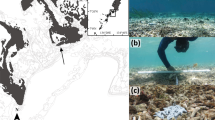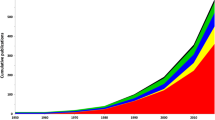Abstract
Unequivocal Eocene suckers from China are for the first time reported here. This discovery demonstrates that catostomids of the Eocene Epoch (some 55-35 Ma ago) are scattered widely on mainland Asia as well as western North America. The present day disjunct distribution pattern of catostomids, with 68 extant species widespread in North America and the northern part of Middle America and only two in the restricted areas of Asia, is the result of their post-Eocene decline in Asia due to the competitive pressure from cyprinids, their Late Cenozoic radiation in North America, and the vicariant and dispersal events triggered by the changed biogeographic landscape. All of these prove to be a historical product of the geological, biological, and climatic changes throughout the Cenozoic.
Similar content being viewed by others
References
Smith, G. R., Phylogeny and biogeography of the Catostomidae, freshwater fishes of North America and Asia, in Systematics, Historical Ecology, and North American Freshwater Fishes((ed. Mayden, R. L.), Stanford: Stanford Univ. Press, 1992, 778–826.
Burr, B. M., Mayden, R. L., A new species ofCycleptus (Cypriniformes: Catostomidae) from Gulf slope Drainages of Alabama, Mississippi, and Louisiana, with a review of the distribution, biology, and conservation status of the genus, Bull. Alabama Mus. Nat. Hist., 1999, 20: 19–57.
Laboratory of Hydrobiology, Hubei, Fishes of Changjiang(in Chinese), Beijing: Science Press, 1976, 1–14, 150–152.
Lian, Z. S., Cypriniformes: Catostomidae, in Fishes of Fujian Province (in Chinese), Part I. Fuzhou: Fujian Science and Technology Press, 1984, 226–228.
Darlington, P. J. Jr., Zoogeography: the Geographical Distribution of Animals, New York: Wiley, 1957, 33.
Gilbert, C. R., Composition and derivation ofthe North American freshwater fauna, Florida Science, 1976, 39: 104–111.
Sytchevskaya, E. K., Paleogene freshwater fish fauna ofthe USSR and Mongolia, Joint Soviet-Mongolian Paleontol. Exp. Trans (in Russian with English summary), 1986, 29: 1–157.
Briggs, J. C., Biogeography and Plate Tectonics, New York: Elsevier Science Publishers, 1987.
Cope, E. D., On the Tertiary coal and fossils of Osino, Nevada, Proc. Amer. Philos. Soc., 1872, 12: 478–481.
Cope, E. D., The vertebrata of the Tertiary formations of the West, Book 1, in Rept. U. S. Geol. Suev. Terr. (ed. Hayden, F. V.), 1884, 1009.
Cope, E. D., Fossil fishes from British Columbia, Proc. Acad. Nat. Sci. Phila., 1893, 45: 401–402.
Wilson, M. V. H., Oldest knownEsox (Pisces: Esocidae), part of a new Paleocene teleost fauna from western Canada, Can. J. Earth Sci., 1980, 17(3): 307–312.
Cavender, T. M., Review of the fossil history of North American freshwater fishes, in The Zoogeography of North American Freshwater Fishes ((eds., Hocutt, C. H., Wiley, E. O), New York: Wiley, 1986, 699–724.
Nelson, J. S., Fishes of the World, 2nd ed, New York: Wiley, 1984, 127–130, 409.
Cavender, T. M., Freshwater fish remains from the Clarno Formation, Ochoco Mountains of North-central Oregon, The Ore. Bin., 1968, 30: 125–141.
Wilson, M. V. H., Middle Eocene freshwater fishes from British Columbia, Life Sci. Contr. Roy. Ontario. Mus., 1977, 113 1–61.
Wilson, M. V. H., Year classes and sexual dimorphism in the Eocene catostomid fish †Amyzon aggregatum, J. Vertebr. Paleontol., 1984, 3(3): 137–142.
Grande, L., Eastman, J. T., Cavender, T. M., †Amyzon gosiutensis, a new catostomid fish from the Green River Formation, Copeia, 1982, 1982: 523–532.
Bruner, J. C., Comments on the genus †Amyzon (Family Catostomidae), J. Paleont., 1991, 65: 678–686.
Cross, F. B., Mayden, R. L., Stewart, J. D., Fishes in the western Mississippi drainage, in The Zoogeography of North American Freshwater Fishes ((eds., Hocutt, C. H., Wiley, E. O,). New York: Wiley, 1986, 363–412.
Miller, R. R., Smith, G. R., Origin and geography of the fishes of Central Mexico, in The Zoogeography of North American Freshwater Fishes, ((eds., Hocutt, C. H., Wiley, E. O.,) New York: Wiley, 1986, 487–518.
Hussakof, L., The fossil collected by the Central Asiatic expedition, Amer. Mus. Novit., 1932, 553: 1–19.
Tang, X., Anew fossil fish from Linli, Hunan, Vert. PalAsiat. (in Chinese), 1959, 1: 211–213.
Cheng, C. C., Fossil fishes from the Early Tertiary of Hsiang-Hsiang, Hunan, with discussion of age of the Hsiawanpu Formation, Vert. PalAsiat (in Chinese with English summary), 1962, 6: 333–343.
Wang, J. K., Li, G. F., Wang, J. S., The Early Tertiary fossil fishes from Sanshui and its adjacent basin, Guadong, Palaeontologia Sinica (in Chinese with English summary), whole number 160, New Ser. C, 1981, 22: 1–90.
Chang, M. M., Zhou, J. J., A brief survey of the Chinese Eocene ichthyofauna, Kaupia, Darmstadter Beitrage zur Naturgeschichte, 1993, Heft 2: 157–162.
Chang, M. M., Chen, Y. Y., Late Mesozoic and Tertiary ichthyofaunas from China and some puzzling patterns of distribution, Vert. PalAsiat, 2000, 38: 161–175.
Forster, J. R., An account of some curious fishes sent from Hudson Bay, Philosophical Transactions of the Royal Society, London, 1773, 63: 149–160.
Chu, Y. T., Comparative studies on the scales and on the pharyngeals and their teeth in Chinese cyprinids, with particular reference to taxonomy and evolution, Biol. Bull. St. John’s Univ., 1935, 2: 1–290.
Eastman, J. T., The pharyngeal bones and teeth of catostomid fishes, Amer. Midl. Nat., 1977, 97: 68–88.
Smith, G. R., Late Cenozoic freshwater fishes of North America, Ann. Rev. Ecol. Syst., 1981, 12: 163–193.
Briggs, J. C., Introduction to the zoogeography of North American fishes, in The Zoogeography of North American Freshwater Fishes ((eds., Hocutt, C. H., Wiley, E. O), New York: Wiley, 1986, 1–16.
Prothero, D. R., The chronological, climatic, and paleogeographic background to North America mammalian evolution, in Evolution of Tertiary Mammals of North America ((eds., Janis, C., Scott, K. M., Jacobs, L. L), Vol. I: Terrestrial Carnivores, Ungulates, and Ungulatelike Mammals, Cambridge: Cambridge University Press, 1998, 9–36.
Janis, C. M., Tertiary mammal evolution in the context of changing climates, vegetation, and tectonic events, Ann. Rev. Ecol. Syst., 1993, 24: 467–500.
Liu, H. T., Su, D. C., Pliocene fishes fishes from Yüshe Basin, Shansi, Vert. PalAsiat. (in Chinese with English summary), 1962, 6: 1–25.
Zhang, M. M., Zhou, J. J., Qin, D. R., Tertiary fish fauna from coastal region of Bohai Sea, Mem. Inst. Vert. Paleont. Paleoanth. Acad. Sin. (in Chinese with English summary), 1985, 17: 1–60.
Zhou, J. J., The Cyprinidae fossils from Middle Miocene of Shanwang basin, Vert. PalAsiat (in Chinese with English summary), 1990, 28: 95–127.
Sytchevskaya, E. K., Neogene freshwater fish fauna of Mongolia, Joint Soviet-Mongolian, Paleontol. Exp. Trans. (in Russian with English summary), 1980, 39: 1–140.
Chang, M. M., Chen, Y. Y., Tong, H. W., Anew Miocene xenocyprinine (Cyprinidae) from Heilongjiang Province, northeast China and succession of late Cenozoic fish faunas of east Asia, Vert. PalAsiat (in Chinese with English summary), 1996, 34: 165–183.
Cavender, T. M., The fossil record of the Cyprinidae, in Cyprinid Fishes Systematics, Biology and Exploitation ((eds., Winfield, I. J., Nelson, J. S,), Great Britain: St. Edmundsbury Press, 1991, 34–54.
Nelson, J. S., Fishes of the World, 3rd ed, New York: Wiley, 1994.
Grande, L., Repeating patterns in nature, predictability, and “impact” in science, in Interpreting the Hierarchy of Nature from Systematic Patterns to Evolutionary Process Theories ((eds., Grande, L., Rieppel, O), New York: Academic Press, 1994, 61–84.
Beard K. C., East of Eden: Asia as an important center of taxonomic origination in mammalian evolution, Dawn of the Age of Mammals in Asia, Bull. Carnegie Mus. Nat. Hist. (eds., Beard K. C., Dawson nM.R.), 1998, 34: 5–39.
Author information
Authors and Affiliations
Corresponding author
Rights and permissions
About this article
Cite this article
Chang, Mm., Miao, D., Chen, Y. et al. Suckers (Fish, Catostomidae) from the Eocene of China account for the family’s current disjunct distributions. Sci. China Ser. D-Earth Sci. 44, 577–586 (2001). https://doi.org/10.1007/BF02875332
Received:
Issue Date:
DOI: https://doi.org/10.1007/BF02875332




